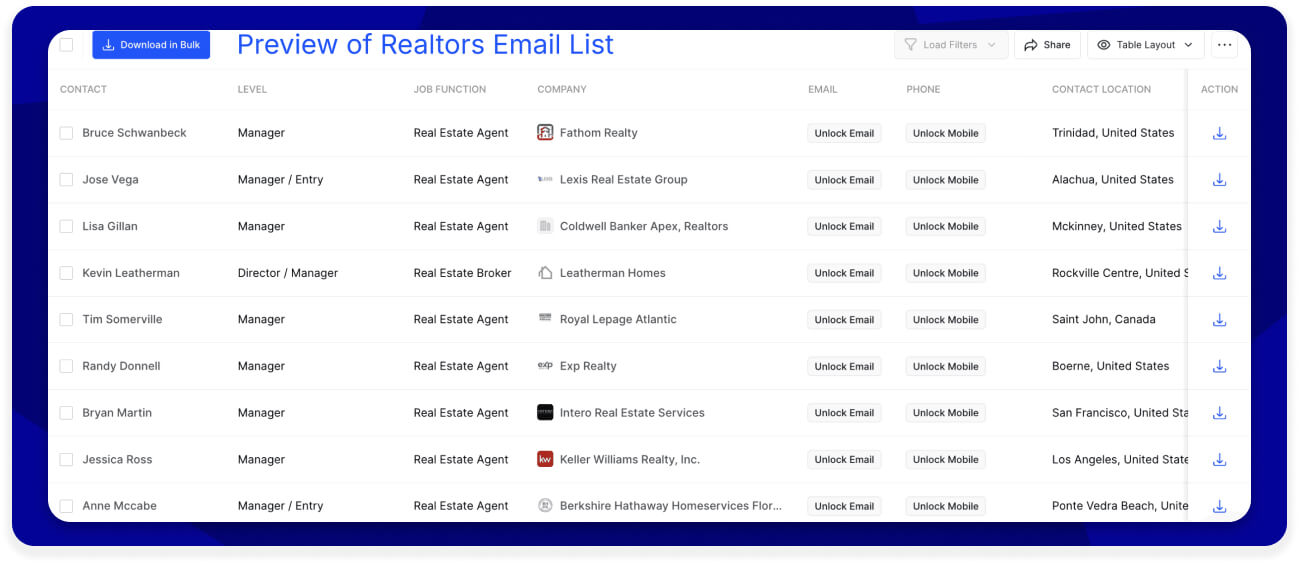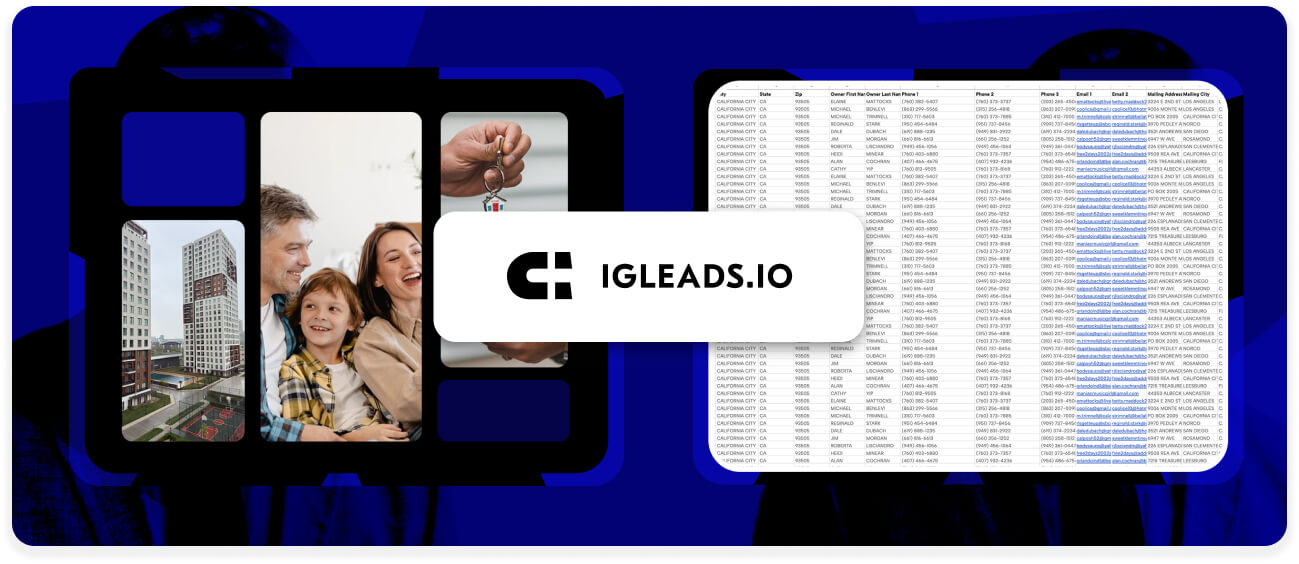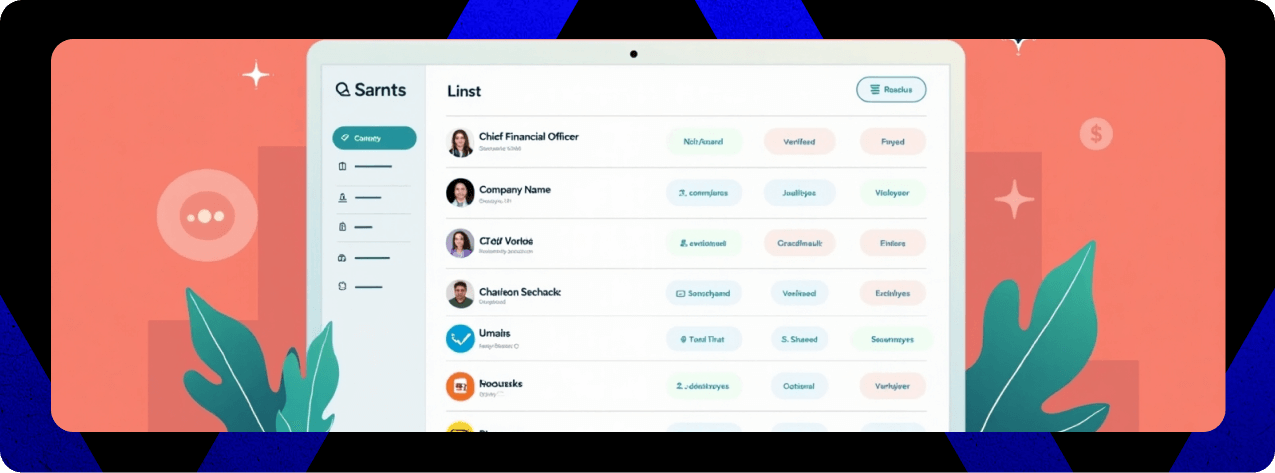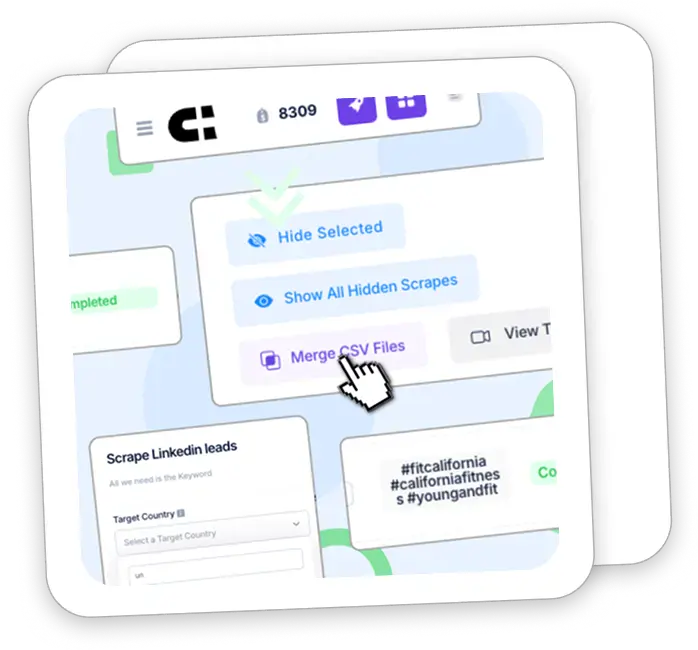Realtor Email List 2025
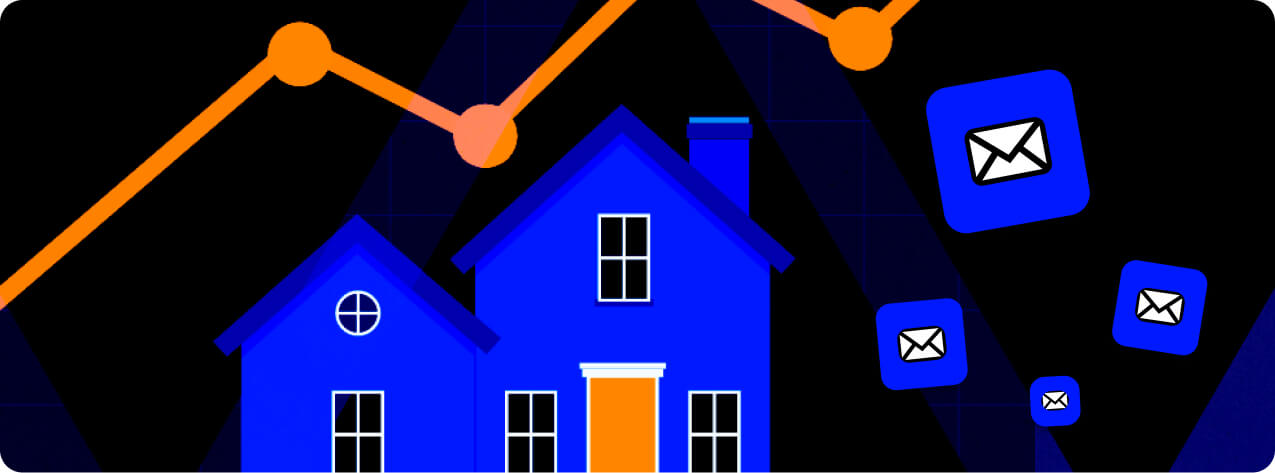
A high-quality email list of realtors gives your marketing team direct access to the professionals driving real estate decisions every day. From residential agents to commercial brokers, these contacts are essential for businesses selling software, financial services, legal solutions, coaching programs, and more.
With over 3 million licensed real estate professionals in the U.S., the real challenge isn’t finding leads, it’s finding accurate, up-to-date contact data that actually reaches the inbox. That’s where a real estate scraper can help, automating the process of collecting realtor emails from platforms like Google, LinkedIn, and other public sources.
- Outdated or full of inactive agents
- Missing key fields like phone numbers or brokerage name
- Harvested from unreliable sources that violate compliance
- Prone to bounce rates and poor campaign performance
- If you want real results, you need a filtered, up-to-date real estate email list that includes name, email, phone number, title, agency, and location. The best providers back their data with 90%+ deliverability and let you filter based on your target audience.
In this guide, we’ll show you how to find, build, or buy a realtor mailing list that actually drives conversions. Plus, we’ll break down what IGLeads offers as a smart, scalable solution.
Why realtor email lists still matter in 2025
Real estate agents remain some of the most influential professionals in local markets. Whether it’s a first-time buyer, a commercial investor, or a family relocating across the country, realtors are the ones making recommendations, brokering deals, and guiding clients through complex decisions.
The influence of real estate agents
Agents aren’t just selling homes, they’re shaping client behavior. They influence which lenders get business, which contractors are hired, which tools and software clients use, and which legal or financial services are trusted. If you’re in any industry that serves homebuyers, sellers, or investors, real estate agents are a key entry point.
The National Association of Realtors reports that over 5 million existing homes are sold each year, and agents handle 90% of those transactions. That kind of volume makes them valuable contacts for B2B outreach.
Why email outreach still works
Despite all the noise on social media, email continues to outperform in terms of ROI. Why?
- Agents check their inbox multiple times a day
- Email is seen as more professional and less intrusive than cold calls
- Campaigns are measurable and scalable
- Emails can be saved, forwarded, or opened later when it’s convenient
Whether you’re promoting software, a lead gen system, or a coaching program, a strong realtor email list gives you a direct line to the people who drive real estate transactions.
How realtor email lists support B2B marketing
An email list of real estate agents opens the door to consistent, direct outreach to professionals who influence millions in property transactions. With the right list, you’re not just blasting out cold emails, you’re engaging a niche audience that actually needs what you sell.
Key benefits of using a realtor email list
- Precision targeting: Filter by location, brokerage, or specialty (commercial, luxury, residential) to match your ideal customer profile
- Efficient campaigns: Email marketing remains one of the most cost-effective channels, with minimal spend compared to paid ads or sponsorships
- Data-backed optimization: Measure open, click-through, and response rates to refine your messaging over time
Whether you’re selling real estate tools, marketing services, insurance products, or investment solutions, these lists give you access to agents who are actively closing deals and guiding client decisions.
Best ways to find a realtor email list
Not all email lists of real estate agents are created equal. If you want quality leads that drive results, you need to know where to source them. Here are the top ways to get a high-performing realtor email list in 2025:
Use real estate directories
Websites like Realtor.com, Zillow, and Homes.com list thousands of licensed agents with public contact details. You can often find their name and brokerage information, location and license status, and links to their personal websites with contact forms or emails. These platforms serve as comprehensive directories where potential clients can easily access agent information and reach out directly through various communication channels.
- Pros: Free to access, high volume
- Cons: Manual scraping, time-consuming, risk of outdated info
Leverage social platforms like LinkedIn and Instagram
Many real estate agents use social media to promote listings and attract buyers. LinkedIn lets you filter by industry, title, and location, while Instagram helps you find local realtors actively posting content.
- Pros: Current data, social proof, outreach potential
- Cons: Not always easy to extract emails without a tool, may require cold outreach finesse
Tap into MLS and association databases
Accessing multiple listing service (MLS) platforms or member databases of NAR (National Association of Realtors) and local real estate boards can give you verified contact info.
- Pros: High-quality, niche-specific data
- Cons: Often restricted access, typically unavailable unless you’re a member
Use email scraper tools like IGLeads
If you want real-time email access at scale, IGLeads helps you extract active realtor emails from Google Maps, Zillow, Realtor.com, LinkedIn, and more. You can filter by location, keywords (like “luxury” or “Keller Williams”), and even export phone numbers when available.
Example: A digital ad agency scraped 850 Miami-area agents and closed 6 new accounts after one outbound campaign using IGLeads.
- Pros: Fast, automated, targeted
- Cons: Manual outreach required, no built-in CRM
What to check before buying a realtor mailing list
Buying an email list of realtors can be hit or miss if you don’t vet the provider. Here’s what you should check to avoid wasting your budget on bad data.
Is the data fresh and verified?
A good realtor list should be updated every 30–90 days. Agents change brokerages often, and email addresses go stale fast. Always ask how often the provider verifies data, and how.
Look for:
- Email validation with bounce protection
- Human and automated verification
- Update logs or recrawl timelines
Can you filter by location or niche?
If you’re targeting agents in Dallas who focus on luxury homes, a generic national list won’t help. You need filtering options like:
- ZIP code, city, or state
- Brokerage or franchise (e.g., Keller Williams, Compass)
- Specialties like FSBO, rentals, or luxury
The more control you have, the better your campaign ROI.
What’s the deliverability rate?
Any good email list should get at least 90% deliverability. If a vendor can’t tell you their average bounce rate, walk away. Some even offer bounce-back credit if a portion of the list fails.
Pro tip: Look for lists that offer phone numbers too, this helps you double-verify contacts and build multichannel outreach.
Can you preview the data?
Reputable providers let you sample the data before you buy. This lets you check:
- Email formatting
- Completeness (name, agency, phone, etc.)
- Whether the contacts are relevant for your niche
If the provider refuses to give a sample or show you the fields included, that’s a red flag.
How to choose a reliable realtor email list provider
Not all real estate contact databases are created equal. Here’s how to pick a provider that won’t waste your time or burn your budget.
Prioritize real-time updates
Realtors switch agencies often, and expired licenses make data decay a real issue. Choose providers that refresh their databases regularly, ideally every 30 to 60 days.
Ask these questions:
- How frequently do you update your data?
- Is the information sourced from public records, MLS feeds, or social platforms?
- Can I see a change log or timestamped crawl date?
The best tools, like IGLeads, automatically recrawl platforms like Google Maps and Realtor.com in real time.
Check for customization options
You don’t need 10,000 random agents. You need the right 500. That’s where filtering makes the difference.
Look for filters like:
- City, ZIP, or region
- Brokerage name
- Property specialty (residential, luxury, commercial)
- Number of active listings
- License status or NAR membership
Tools that let you build segmented lists on demand will save you time and increase reply rates.
Don’t just go cheap — compare value
Cheap lists from shady sources can get your domain blacklisted. Reliable email list providers may charge more, but they usually back it up with:
- Higher deliverability (90% or better)
- Fewer spam traps and duplicates
- Accurate, recent data
Some offer CSV exports with extra fields like phone numbers, websites, and social links, making multichannel outreach easier.
Read reviews, not just promises
Don’t fall for vague claims like “access to thousands of agents.” Look for real testimonials that speak to data quality, not just list size.
Signs of a trustworthy provider:
- Bounce-back guarantees
- Real user reviews with outcomes (calls booked, responses, etc.)
- Transparent sourcing methods
- Responsive support team
Why IGLeads is a trustworthy provider for realtor emails
If you’re tired of outdated data, bounced emails, and overpriced lists, IGLeads is built to solve exactly that. It’s not just another lead database, it’s a scraping-powered engine that gives you control, speed, and quality.
Here’s what sets IGLeads apart:
- Real-time scraping from Google, Maps, and Realtor.com – You’re not getting some dusty static list. The platform pulls live agent data, including emails, phone numbers, and brokerage details.
- Custom filters by location, keyword, or business name – Whether you want Miami agents or luxury-focused brokers in Dallas, it’s point-and-click easy.
- Cloud-based, bulk exports – No browser extensions or slow manual copying. You get fast, organized data in downloadable CSV files.
- Legally sourced, publicly available contacts – All data comes from open B2B sources, staying compliant with CAN-SPAM and GDPR when used properly.
Trusted by thousands of marketers
“We pulled 2,100 realtors from Google Maps in under 20 minutes and launched our first cold email campaign the same day.”
– Growth Lead, PropTech Startup
“Our bounce rate dropped to under 3% after switching from a paid list provider to IGLeads.”
– Real Estate SaaS Founder
If you’re running outreach to agents, brokers, or local real estate offices, IGLeads gives you the data foundation to actually get replies, not just more unsubscribes.
How to use a realtor email list for outreach
Once you have your email list of real estate agents, the key is putting it to work in ways that drive real results. Here’s how top teams use realtor email data for prospecting, marketing, and sales in 2025:
- Cold outreach – Introduce your product or service to agents in a specific ZIP code or market with personalized emails.
- Partner recruitment – Use email campaigns to pitch brokerage partnerships, software integrations, or referral programs.
- Newsletter campaigns – Send regular updates with helpful tips, local data insights, or exclusive offers to stay top-of-mind.
- Event promotion – Invite agents to webinars, open houses, product demos, or networking events.
- Account-based marketing – Sync the list with your CRM and target high-value brokerages with tailored follow-ups.
The best results come from segmentation and personalization. Target by state, firm size, property type (commercial, residential), or even keywords in bios like “luxury” or “investment.” That’s where a customizable tool like IGLeads makes the difference.
Industries that target real estate agents via email
A quality realtor email list isn’t just useful for real estate software companies. A wide range of industries actively reach out to agents for partnerships, product promotion, or sales opportunities. These include:
- Mortgage lenders – promoting home loan solutions agents can refer to buyers
- Home insurance providers – building co-marketing relationships with agents
- SaaS tools – offering CRMs, marketing platforms, or transaction management software
- Interior designers and stagers – targeting agents who handle listings
- Recruiters and brokerages – looking to attract top-producing agents
- Lead generation platforms – pitching traffic or buyer/seller leads
- Education providers – marketing CE courses and certifications
Agents are active dealmakers. If your offer helps them close faster, earn more, or build trust with clients, they’ll listen, especially if it’s well-timed and well-targeted.
Examples of effective realtor email campaigns
The best-performing email campaigns to real estate agents tend to follow a clear structure: relevance, brevity, and value. Below are a few real-world examples of what works:
- Tool offer with niche use case
Subject: “The CRM Top-Producing Agents Use for FSBOs”
This type of campaign calls out a specific challenge (e.g. managing FSBO follow-ups) and introduces a proven solution, earning more engagement than generic sales pitches. - Educational event invitation
Subject: “Join 3,000 Agents at the Free Lead Gen Masterclass”
Agents are always looking to improve. Offers like webinars, masterminds, and free training attract opens and shares, especially when peer results are included. - Done-for-you service pitch
Subject: “We Build Your Listing Website in 3 Days – Free Trial”
Realtors appreciate time-saving solutions. Clear value, speed, and no-risk trials tend to convert well if the offer is directly tied to lead generation or listings. - Local market data alerts
Subject: “Phoenix Zip Codes with the Highest Buyer Activity Right Now”
Personalized insights or data-driven alerts give agents useful market intelligence and increase email engagement, especially when tied to their zip code or city.
How to measure performance and ROI with a realtor email list
Measuring the success of your realtor email list means going beyond opens and focusing on what actually drives revenue. Here’s how to track what matters:
- Open rates
Aim for a 22% to 27% open rate, which is typical for real estate–focused campaigns. Personal sender names, short subject lines, and localized terms often improve performance. - Click-through rate (CTR)
A good CTR is between 2% and 4%. If you’re offering tools, guides, or webinars, make sure the call to action is above the fold and clearly worded. - Lead-to-call conversions
Track how many agents book a call or reply to your outreach. Anything above 5% is solid, especially if your list is segmented by geography, brokerage, or license status. - Bounce rate
Clean lists should maintain a bounce rate below 5%. High bounce rates hurt deliverability and signal low list quality. - Unsubscribe rate
Staying under 1% shows your content is relevant. Higher rates suggest poor targeting or too much frequency.
Effective campaigns don’t just rely on pretty templates. The winning formula is a clean list, a segmented message, and a clear benefit to the agent.
Why IGLeads is your advantage in realtor outreach
Realtors get pitched nonstop, so if your message isn’t useful, timely, and personalized, it’s getting ignored. The difference between being deleted and getting a reply often comes down to data quality.
That’s where IGLeads gives you a serious edge.
With IGLeads, you can generate a realtor email list in minutes, filtered by location, license type, or keyword, so you’re always reaching the right agents in the right market. No more buying bloated databases or wasting time on manual research.
Whether you’re promoting real estate marketing tools, CRMs, finance solutions, or local services, IGLeads helps you:
- Find and export active realtors in your target region
- Build segmented lists for hyper-personalized campaigns
- Scale your outreach with clean, export-ready data
If you want booked calls and faster sales cycles, start with smarter data. Try IGLeads today and start connecting with the agents who actually move the market.
More real estate lead generation resources
- Get Fresh Real Estate Email List 2025
- Get Fresh Real Estate Agents Email List 2025
- Get Fresh Mortgage Brokers Email List 2025
- 15 Best Real Estate Lead Generation Software for 2025
- Email Extractor Ultimate Guide 2025
- How to Get a Homeowner Mailing List in 2025?
Explore more lead generation strategies and tools
- B2B Lead Generation Solutions – Guide for 2025
- How to Build a High-Quality B2B Email List for Outbound Marketing
- Buy Email Lists for Marketing in 2025: Complete Guide to Business Leads
- Why Scrape Google Maps? Use Cases for Sales, Marketing & SEO
- B2C Lead Generation: The 2025 Playbook
- 15 Best Lead Generation Companies for 2025
- Best B2B email list providers in 2025
- Top Lead Generation Agencies Compared (2025)
- 18 Best B2B Lead Generation softwares in 2025
- Lead Generation Guide: Strategies & Tools for 2025
Frequently Asked Questions
You can build one manually from real estate directories, or use tools like IGLeads to scrape agent contact data from Zillow, Realtor.com, and Google Maps.
Yes, as long as the data comes from publicly available sources and you comply with email marketing laws like CAN-SPAM and GDPR.
Keep it brief and relevant. Focus on how your service helps them get more leads, listings, or closings. Include a clear call to action.
Typical open rates range from 22% to 27%. Personalization, strong subject lines, and segmenting your list can improve performance.
1–2 times per week is a safe starting point. Watch unsubscribe and open rates to adjust frequency without overwhelming your list.
